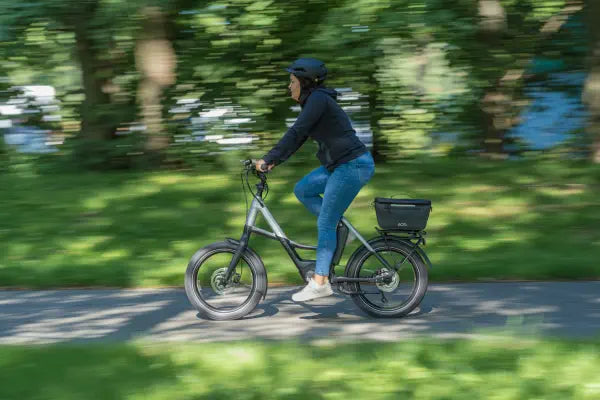
Ebike Jargon Explained
If you venture down the rabbit hole that is electric bikes, you will soon realise it is filled with terms and jargon. If you are new to it, it can be confusing. In this article we aim to clear up any ambiguity, clarify any uncertainty and give you a list of Ebike terms with a simple, easy to understand explanation. So don’t worry, your Ebike jargon will be explained.
Ebike Battery Jargon
The battery is normally the most expensive component of an electric bike. It’s the part that supplies electrical energy to the motor system. Think of it as no more than a fuel tank. Basically, bigger batteries = bigger fuel tanks = more range. The following terms are associated with batteries.
Lithium-ion (Li-on) batteries
Most Ebikes use lithium-ion batteries. They are favoured over other types of battery because they are lightweight for the capacity they store. Lithium-ion batteries are popular elsewhere too. Consequently, they can be found in a range of electrical devices, including smartphones, laptops and even Tesla cars!
Check out our Battery FAQs article for further info
Range
Range is simply the distance an Ebike can travel with the motor engaged and correspondingly assisting the rider, on a single charge. The total distance of a ride will always be greater because there will be times when motor assistance isn’t required like riding downhill, for example. The range of an electric bike will be affected by a number of factors. These include the capacity of the battery, weight of bike and rider, the terrain, the assistance levels used, tyre pressure, tyre tread, air temperature and lastly wind direction.
The Bosch Range Assistant can help predict your range

Volts (V)
A volt is the standard unit of electromotive force to describe the difference in charge between two points. It’s the “push” that moves electrical charge from one point to another. In simple Ebike terms, higher voltage electric bikes typically go faster. It’s common to see batteries specified as 36V or 48V. A higher voltage battery will draw more current which means you can go faster with a 48V bike.
Amps (A)
Amps are the standard unit of measurement for current, which is the rate of flow of electrical charge. The higher the amps, likewise the faster the flow of electrical charge. Pressing hard on the pedals on an Ebike will mean more amps are drawn from the battery to make the motor work harder.
Ampere-hours (Ah)
Ampere-hours is a unit of measure that describes the rate of the flow of current over time. It is sometimes used to describe a battery’s capacity but isn’t much use without taking into account voltage (V). A bigger Ah does not mean it’s bigger. Watt-Hours (Wh) is a better way to compare battery sizes.
Watt-hours (Wh)
This is the energy capacity of a battery as it more accurately determines the energy that can be stored in one and therefore should be used to compare battery sizes or capacities more accurately.
Wh = V x Ah
Watt-hour (Wh) includes the Voltage (V) and the Ampere-hour (Ah). Conversely, it also determines how far you might go on a full charge.
Example: A 48V, 8Ah battery has a 384Wh capacity vs a 36V, 10Ah battery which is 360Wh. The lower Ah battery has a bigger capacity.

Ebike Motor Jargon
The motor is the key component of an ebike. It’s the part that takes electrical energy from the battery and converts it into mechanical energy or pedal assistance. The following are terms that are associated with Ebike motors.
Power
Power is the rate of “doing work” over time. The more power a motor produces, the more energy it converts each second. This simply means more powerful Ebikes are faster than less powerful Ebikes because they produce more mechanical energy (or do “more work”) per second.
Watts (W)
Watts are a unit of measure used to describe the power output of a motor. The standard way of measuring power is in Watts. UK legal Ebikes have motors restricted to 250W.
Torque
Torque is the rotational power of the motor. The higher the torque, the more turning power the motor produces, and the better the bike is at assisting the rider. Higher torque motors will cope with steep hills and moving bikes loaded with luggage easier.
Newton-metres (Nm)
Torque is measured in Newton-metres. A higher Nm value means a higher torque.

EBike Types Jargon
Not all electric bikes are created equal. A bike with an electric motor isn’t enough to define it as an Ebike. Some are legal, some are illegal, some are not even Ebikes as defined in UK Law. There are a few different types and they have certain features that set them apart from each other.
For further information on the different styles of Ebike click here
Pedelec (or EAPC)
A Pedelec, otherwise referred to as an Electrically Assisted Pedal Cycle (EAPC) is a bicycle with an electric motor. It does not provide assistance unless the rider is pedalling. In the UK and Europe, Pedelecs are limited to a power output of 250W and a top assisted speed of 15.5mph (25kph). The motor will cut out when the bike exceeds this. They are legal to ride in the UK for over 14’s.
All our Electric Bikes are UK Legal.
S-Pedelec
An S-Pedelec (S stands for Speed) is the same as a Pedelec, but the speed at which the assistance cuts out is 45kph. The motors also have a power output upto 500W. They are not legal for general use unless riders have a driving licence and they are registered and insured .
Twist & Go
Twist & Go bikes are Ebikes with a throttle. Riders do not need to pedal in order to make them move. Much like a motorbike or moped, you simply twist the throttle and go (hence the name). These aren’t road legal in the UK and are treated the same as electric motorbikes.

